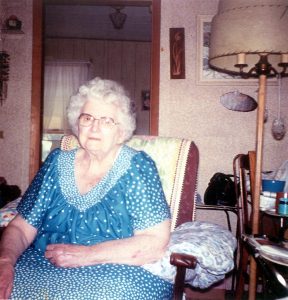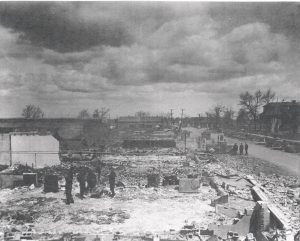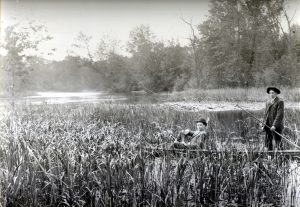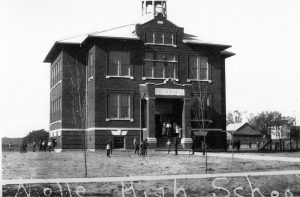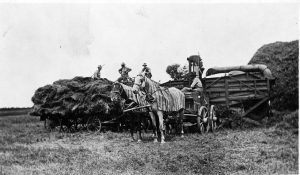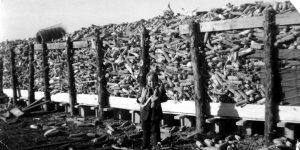Ruth Kiersma
THE SETTLING OF THE GRAND MARSH OF THE KANKAKEE
RIVER
Interview by Laverne Terpstra, transcribed by Shirley Zeck
April 19, 1993
I was born in Hebron, Indiana in 1905, March 3. I lived there until 1920. My father died in 1915. He was a housemover and put down wells and put up windmills. So, he had worked around through the country. He worked over here at DeMotte.
I remember one building that he moved. I know he moved more than that. This was that one that was where the fire started when we had the big DeMotte fire. It was right next to that on the west side of the alley. It had saloon marked on the front of the window. I always remember, he moved that off of Main Street and down there.
He stayed at the Troxell Hotel and that was where the Shell Station is today (713 Halleck SE). It was one of these saltbox houses as they called them, you know. It was pretty around there. I remember there were trees and everything around there.
I always enjoyed traveling from Hebron to Virgie to visit my Aunt. I always remembered the trips through DeMotte and how it has changed. I always loved the trip from Morrows to this side of the marsh. That was so beautiful in there. The tree just formed an arch practically over the road. The road was so narrow that if you seen somebody coming you stayed on the bridge until you could pass on the bridge. You couldn’t pass on the road between the bridges. The first fox I had ever seen was along that road. He was sitting down in the ditch in the sunshine getting a drink of water, I guess.
When you got to the edge of the marsh, it was still low ground and water and that but there was always bullgrass and cattails waving in the breeze. It was just before you got to the railroad track (the Gifford track – North of Maks’ ¼ mile). It was pretty in through there. I don’t think there were any houses until you got to up to Mak’s (14100 N US 231) in the early days that I can remember. There was so much of this bullgrass and it was always waving in the breeze. It was always in the summertime when we traveled through there.
When you would go across the old wooden bridges with the horse and buggy they would rattle and clatter. It was all wooden plank bridges at that time.
It was before the river was dredged that I remember. It was wide, too at the time. There were some cabins out there close to the river.
People always went out there fishing, I know that. You could pass on the bridges.
The road was low to what it is now. I don’t know if people swam in it.
My father worked where the Evans place is now (13861 N 700 W). I don’t remember what the name of it was at that time. But I know he did work with the windmill. Just what kind of work he did there I don’t know but he did work quite a while at that place. Some windmills they would put tanks up in the air and pump water into the tank and then pipe it into the house.
My father’s name was Corbin Aylesworth. I had two sisters and a brother. We lived in Hebron east of the stoplight about six houses east.
He did work all around. I don’t even remember all the places he went. He’d go quite a ways, like when he would come over here he wouldn’t come home.
He’d be gone. He had to travel with horses and it was quite a ways. I heard him tell about how they would move a house and the women would cook the meals while they were moving it. Then they would stop a while and eat.
Just from memory, it seems to me like the Troxell Hotel would be about like the heritage Inn in Hebron. That building always made me think of the Troxell Hotel.
He passed away in April 1915. I didn’t travel any more by horse and buggy through here to amount to anything. They always had to come and get us if we came over here to visit.
We had to get rid of our horses and that. It seems to me that someone bought some of our moving stuff but I don’t remember who it was.
From then on it seemed to me that people slowly didn’t move houses as much as they did in the earlier days. Now you never hear of it.
My mother remarried in August of 1920 to R.G. Gasaway from Virgie and we moved over here. Then I finished eighth grade at the Virgie School. Then I didn’t go to school anymore. Dad figured when you got through eighth grade why you had your education.
I met Bob in 1921 and we were married in 1923. I have lived up here since 1934. When we were first married we lived on the Otis Ranch where Johnny Dykhuizen lives (7761 N 800 W). Bob’s folks had lived there since 1906 and we lived there ten years.
We farmed. We had a few hogs and three milkcows. We didn’t ship milk like his folks did when they lived there. Then we moved up here and when the electric came through he got into wiring, Bob did. That was his love of life. He liked that so well.
After the REMC came through Bob started wiring. How he got started was the person that wired the house here did so much wrong it had to be fixed. So that’s when he started studying wiring and went into it and he enjoyed that.
He wouldn’t do it unless it was done right. REMC said he’d come and ask and they could depend on it. They always knew it was done when he did it. He studied it himself. He figured it out.
He had a book I think, from Sears.
Whenever there was something he didn’t understand he would ask REMC. They would tell him what to do. They were so good about instructing a fellow how to do something.
I think after my father died and we were left alone and mother had to go work was one of the hardships of growing up. I had to take care of the three younger ones. I was ten when he died.
I got along fine. The kids understood that they had to mind me. Wherever she worked we had instructions not to come there. We weren’t to run in or out. We never did.
We went to school in Hebron. We walked. We didn’t live very far (east of the stoplight). The school was west and south. It wasn’t too far. It was close to the Methodist Church in the next block. There are apartments houses where the school used to stand. It was a full twelve grades.
There were some from DeMotte that used to go there to high school. I think Emmet Erwin was one of them. It seems to me like it. I think Florence Story came be fore they had the high school in DeMotte. They would come with horse and buggy.
I had some banty chickens and I’ve got a picture where I’m holding one of my banty chickens. They were such pets. Then I had a white rabbit and it kept digging out. We had an awful time keeping it in.
When ballbearing roller skates came in, I sold my rabbit and got my ballbearing roller skates.
I learned to roller skate when they put in the sidewalks. I suppose it was around 1910 or 1911, something like that. I don’t just exactly remember, but they clamped on the sole by the toes and it tore the soles off with the skates that clamped.
Before concrete sidewalks we had wooden sidewalks. If you dropped a penny why it was gone.
I always enjoyed cooking for threshing gangs because two or three neighbor ladies would come and help you and you’d have a picnic out of it is the best way to put it.
Maybe you would have fourteen, fifteen or sixteen men, but there would be quite a few women and maybe some kids. It was a pleasure, a picnic really, even if it was work.
You always had somebody helping you. Well, I’ll come and help you today. They just didn’t set back and not say it. They would come and help you.
It didn’t seem like a lot of work really at the time. It was getting the meat and stuff ready, because you didn’t have refrigeration. Sometimes you had to hurry to town in the early morning and get your meat. Then get it home and get it in the oven and get the old cook stove a going.
Sometimes it would be a couple of days. Because if you had quite a little bit of oats and wheat and stuff, you couldn’t get it all done in one day.
I think the cornhusking was more work. We’d hire fellows to come in and help us. They’d come in the field early in the morning and some of them would set and wait at the end of the field so they could see the ears of corn.
I had to have dinner ready very early, around ten o’clock, because they started to come in with their loads and then they had to scoop the corn into the corncribs. It was all earcorn in those days, you know.
They would eat and then they’d back to the field again. They didn’t all eat at the same time because some of them started earlier than the others. That was back in the 20’s. We’d generally have three or four men working. Mr. Zimmerman was one of them who always came and shucked corn for us. He was always early in the field, so he’d be in early for his lunch. During threshing you’d have fifteen anyway that many.
I had a big table. I could stretch it out and set sixteen of them down to the table at a time. Especially on threshing they’d come in and eat and then they would go again.
Then the women would eat after they got rid of the men. There was not too much food left over.
There wasn’t a way of keeping it either. You didn’t have refrigeration. We made pies, cakes but we didn’t have to make coffee in the morning and afternoon.
We didn’t have a summer kitchen, but it was a part of an enclosed porch and I would wash out there in the warmer weather. But in the colder weather I had to do it in the house. I’d heat the water in the boiler on the stove. I had one of these open machines, a rocker machine, to wash with. It did a pretty good job, but it was an all day job you might as well say. It was done by hand with the rocker machine. You would rock back and forth just like two washboards running together with the clothes between them.
You could just figure when you had them clean. I think our soap was Fels Naptha, a lye soap. They had American Family. I don’t think they had bleach, only lye. I never used that, just soap and washed them and used a little bluing in the rinse water. You had to get them on the line as quick as you could so you could get them dry. You didn’t have any way drying it like today. We did the overalls last.
Today you put a load in the washer and it all goes through. Back then we used the same water and added a little water to it when it got lower. We dumped the water out and didn’t do anything else with it.
I learned to crochet and embroidery in my leisure time. I didn’t do too much of it in the early days. I did more of it after I got older. I would read some, but we didn’t have too many games either to play. I think we did a lot of reading more than anything else. We didn’t have radios until around 1920.
On Christmas we would go to Grandma Aylesworth’s when we were kids. I can remember us going there. They only lived three doors from us. So they were always close. They would have a big dinner and we would go there. We would give gifts but not much. The last Christmas in 1914, before my father died, he had been working (had quite a bit of work that year). They had started putting in the water system in Hebron. Ma and him both bought us presents that year. I still have both presents. One of them is a little set of doll dishes and the other is a map. Today you would call it a jigsaw, but it has little bigger pieces. But it was put together and was the United States.
My mother had neuralgia bad that year in her face, but we had a nice Christmas. That has always stayed with me. It was special because we had those presents. Then when my father died in April, I wouldn’t play with that set of doll dishes. I wanted to be sure to save it and I’ve still got it today.
My mother sewed for the family. Somebody would give her a coat and she would make it over for me. She was a good seamstress and could make something out of anything given to her. She would get her patterns from Bryant and Dowd store right on the northeast corner. There was clothing in the front part of the store and the back part was the grocery store. In Hebron it was easy to go to the store. She had worked there before she got married.
We had a garden, but we didn’t can. I don’t think they knew how at that time. I can remember later on in years we canned beans and cooked them in the hot water. In the winter we had dried beans. We didn’t have much variety in the winter, navy beans and that. But to have a variety of vegetables like today, we didn’t have that. Some people had a cow in town. We had horses when my father was living. He had to have a team of horses to move his stuff.
I remember the Hebron tornado in 1917 when it did so much damage. It hit the northwest corner of town. There was one boy killed in the storm. Everything was coming through the house, pieces of the elevator and everything. When he ran out he got hit in the head and was killed. There was another man that got hurt pretty bad. He died later from it.
That storm was really bad. At our place we didn’t get too much damage, but we were scared. We stayed in the house, there were no warnings at that time. Just that storm come up and we went out after the storm. We only had one door we could get out of because there were trees in front of them. Mother looked and said “the roof’s off of Crawford’s house”. Going north over the railroad there is a big brick house on the hill, it’s still there today. That house was damaged bad and we could see that from where we lived.
There were some railroad men living in a boxcar and they got burned, not seriously. They were cooking supper. There was an old car that had lime in it and they got that in their face. That was something, it took quite a while to get it repaired. There weren’t too many of them that couldn’t stay in their homes. They probably moved in with relatives or a neighbor.
I had an uncle out five miles east of Hebron, their place was destroyed, but they all survived. I had an aunt and uncle over by Kouts and their house was completely destroyed. They ran in the basement, they dropped the door shut. The house went up, the floor of the big porch slid right over the basement. When the house came down it came in the same place. They were able to get out and they weren’t hurt.
My great-grandparents came and settled where at the time they called it the Aylesworth Switch. Now I think it is where the Heinhold Elevator is. My great-grandparents bought, I don’t know how many acres, a big amount. They had come with their money sealed in the bottom of a lunchbucket. That’s the way they had carried their money so it wouldn’t get stolen. One of the places is till in the family today where my grandparents lived out there. There was quite a big family because of the generations here.
On the Fourth of July we always had firecrackers and sparklers. After my father died, the neighbor across the road worked (a young fellow) in Valpo and he’d always bring us kids
some firecrackers and that. He would come over and help us shoot them off so that we wouldn’t get hurt. We always thought so much of him. I think the Fourth of July was the main thing. They would have some rockets. That would be between 1915 and 1920 when this fellow lived right across the road.
I can remember when they had movies and other things going on sometimes too. You had to go upstairs over Konovsky’s building, next to the alley (804 S. Halleck). They had movies up there. That was back in the early 20’s. Later they had summer movies, they would put their screen up on the bank and the people would set along the street and watch the movies. The bank was built then already (807 S. Halleck).
Tent shows used to come to town once in a while. That I can’t remember too much. They would travel from one town to the next and maybe stay for several days and put on plays and a circus show. You always knew when they were going to come. They would come with horses and wagons. They put up a sign, we knew they were going to come to town. They would go from one town to the next. That was the time the kids would go to the tent show.
We had to take our eggs and a can of cream to town. Then they would test it and we’d get paid for the butterfat in the cream. Maybe you’d get three dollars for a thirty dozen case of eggs. Yet in those days, maybe you’d go home with money because the groceries weren’t so high. You couldn’t get much for a case of eggs today at that price.
I can remember when World War I was, that’s when I lived in Hebron. We had some hens, we had a dozen eggs and Ma told me that she would put them in a bag. I had to take them up to the store and buy something. I had 76 cents for that dozen of eggs. I thought I’d never see that again. I’ve always thought about that, to get that much for a dozen eggs. You’d never see it again. Now look what you pay for them.
We went to Uncle George Covers for Aunt Emmie’s funeral and we stayed for a little over a month. Then the Virgie church had their first service in January. I was at that service. We stayed there until some time in January and I went to school in Virgie, so I wouldn’t lose out. I took the exams there and took the same exam back in Hebron.
The first Sunday in church they had quite a large church service. Then they dedicated the church in September. That was in 1920. The church has been doing good ever since. They would have ice cream socials and that to make money and keep going with. It is always interesting to me what goes on. The Hollanders in leaving Holland because of the persecution came to America and the east coast. They travelled across the United States to Zeeland, Michigan, settled there and that was the beginning of the Zeeland and Holland Michigan area. This here coincided with the English people leaving England about the same time and coming to America. According to my family history with this here Holland story that has to be a true story of how their hardships and how they left Holland and England over persecution and came to the United States. Some finally came to Indiana here, Aylesworth, because just one brother came to the United States and I’m in the tenth generation that came to the United States. And so this Holland story just coincides with my history, it has to be a true story. It was a most interesting story when you get to reading it.
This concludes the interview with Ruth Kiersma.


